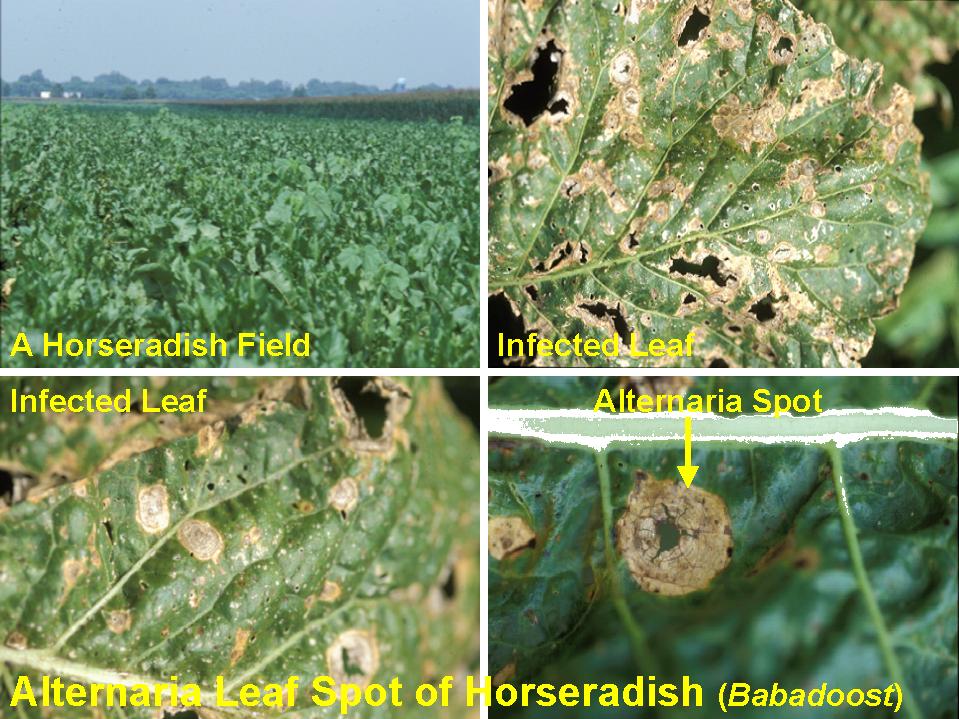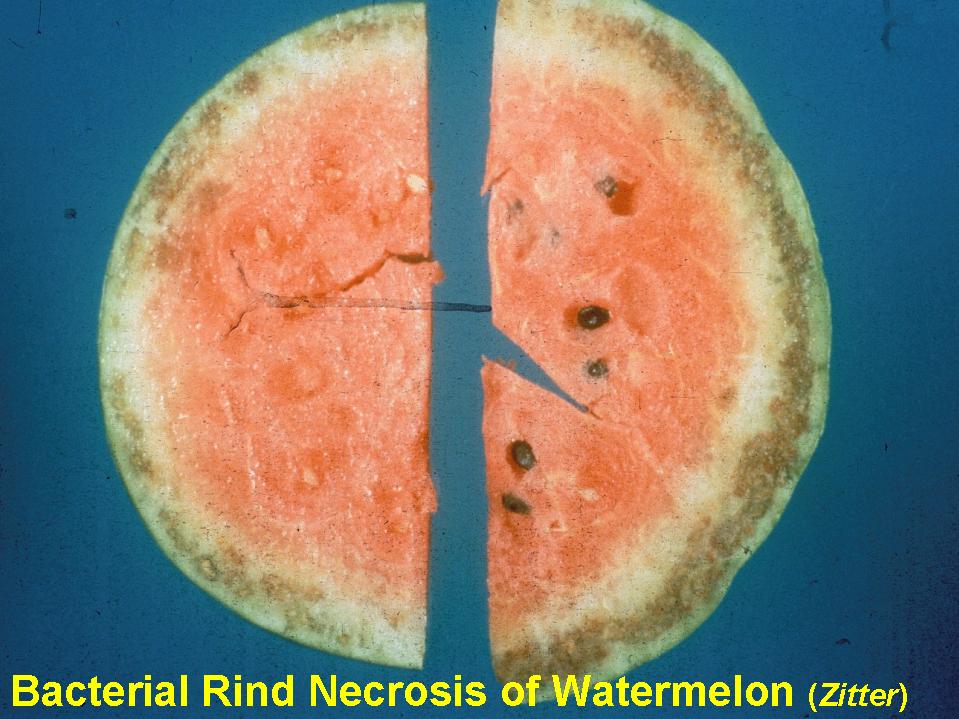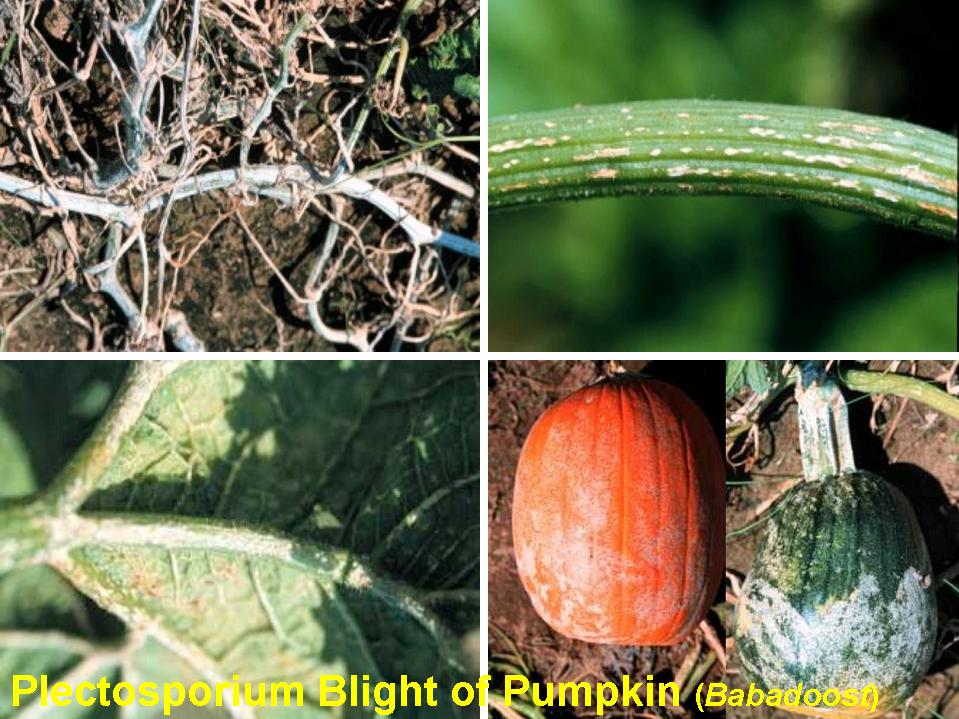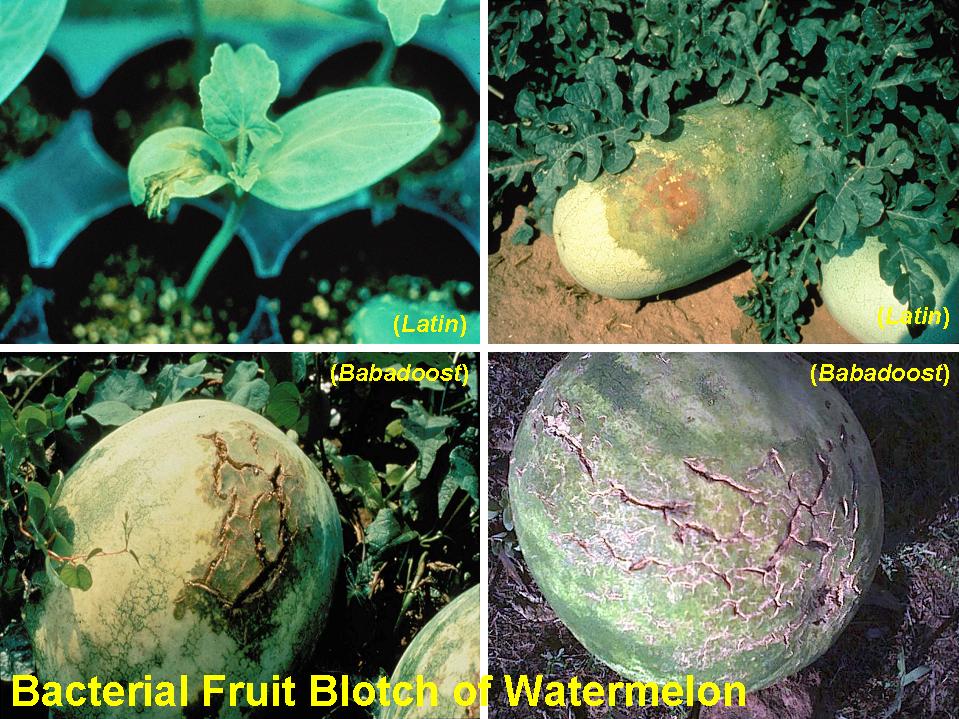
Alternaria Leaf Spot of Horseradish. Alternaria leaf spot of
horseradish is caused by the fungus Alternaria brassicae. This disease is characterized
by distinct spots with concentric rings on leaves. In wet conditions dark dusty
fungus growth develop on the spots. This disease was first reported from Illinois
in 1999.

Bacterial Rind Necrosis of Watermelon. The bacterial
rind necrosis of watermelon is caused by an Erwinia species. The disease causes
a brown, corky, dry necrosis of the interior of the rind, which rarely extends
into the flesh. The affected area may vary from a single small spot to the entire
rind. The symptoms resemble those attributed to boron and calcium deficiencies.
There are rarely any external symptoms on watermelon. In the case of the severe
internal necrosis, the fruit may be misshapen. This disease was first reported
from Illinois in 2000.

Tobacco Etch Virus on Tomato. Tomato plants infected with Tobacco
etch virus (TEV) appear somewhat stunted with mildly mottled, slightly distorted
foliage. Plants infected at an early age are severely stunted. The fruit are
mottled and do not achieve marketable size. TEV is a potyvirus, consisting of
long, flexuous particles about 760 x 12-13 nm. This disease was reported from
southern Illinois in 2000.

Plectosporium Blight of Pumpkin. Plectosporium blight (Microdochium
blight) of pumpkin is caused by the fungus Plectosporium tabacinum. All parts
of the plant may be affected. Spindle-shaped, tan to white lesions develop on
stems, leaf veins, petioles, and peduncles. Stem and petiole lesions can result
in the death of attached leaves, and defoliation can occur in severe infection.
Infected stems are dry and brittle. On fruit, the fungus causes white or silver
russeting. Individual lesions are less than 1/4 inch long, but often coalesce
to form a continuous dry, scabby surface. This disease was first reported from
Illinois in 2000.

Root Knot Nematode of Horseradish. Root knot of horseradish is
caused by the nematode Meloidogyne incognita. Characteristic symptoms of the
disease appear on the roots. Infected roots swell at the point of invasion and
develop into the typical root knot galls. Several infections take place along
the same root, and the developing galls give the root a rough, clubbed appearance.
Root knot nematode of horseradish was first identified in Illinois in 2001.

Bacterial Fruit Blotch of Watermelon. Bacterial fruit blotch
of watermelon is caused by the bacterium Acidovorax avenae subsp. citrulli.
The characteristic symptom of this disease is a dark olive green stain or blotch
on the upper surface of the fruit. The blotch is first noticeable as a small
water-soaked area, but it rapidly expands and covers much of the fruit surface.
As the blotch increases in size, the area around the initial infection site
becomes necrotic. In advanced stages of the lesion development, the epidermis
of the rind ruptures. Fruit lesions rarely extend into the flesh. Rapid extension
of fruit lesions usually occurs during the few weeks prior to harvest. The pathogen
also infects leaves, but the symptoms on the leaves may be inconspicuous. Leaf
lesions are small, dark brown, and somewhat angular. This disease was first
reported from Illinois in 2001.

Dodder. Dodder (Cuscuta spp.) is a parasitic plant and affects
the growth and yield of infected plants. Orange or yellow vine strands grow
around the stems and the other aboveground parts of the plants. The growing
tips reach out and attack adjacent plants. Dodder-infested patches in the field
continue to enlarge during the growth season. During late spring and in the
summer, dodder produces massed clusters of white, pink, or yellowish flowers,
which soon form seed. Dodder was observed in several farms throughout Illinois
in 2001.

Southern Blight of Pepper. Southern blight of pepper caused by
the fungus Sclerotium rolfsii. Characteristic symptoms of this disease are sudden
wilting and death of the plant. The stem is rotted at ground level, and there
may be some discoloration of vascular tissue part way up the stem. Often, particularly
in wet weather, there are fan?like webs of whitish mycelium around the rotted
stem. These will develop sclerotia that look like mustard seed. On fruit near
or on the ground there is a rapid rot with abundant mycelium and sclerotia.
This fungus is a soilborne pathogen and has a broad host range. The disease
was observed in one bell pepper field in central Illinois in 2002.
